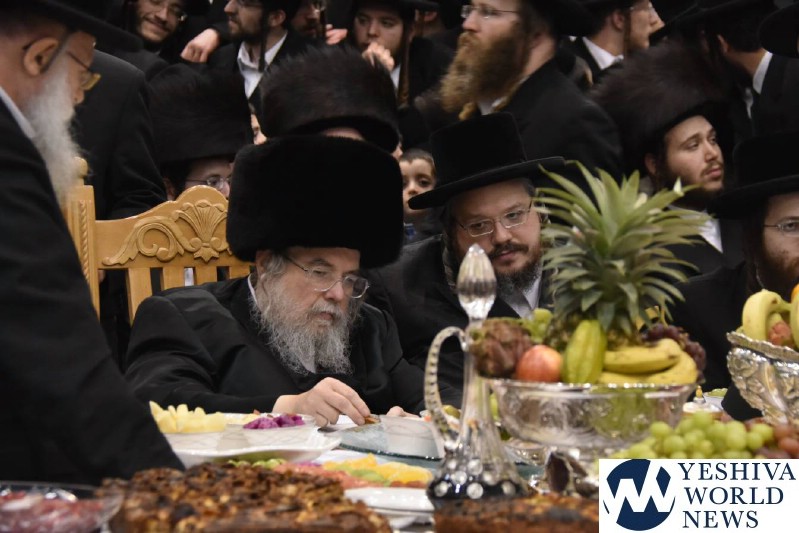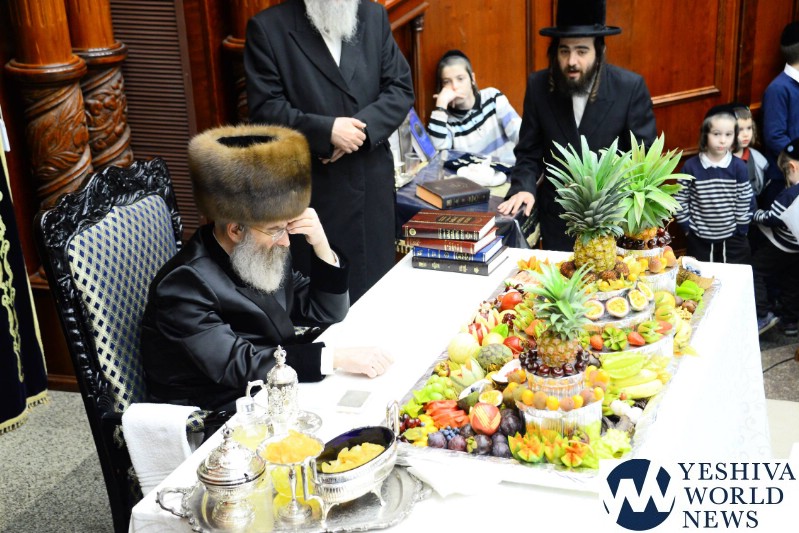Rabbi Yair Hoffman
Tu B’Shvat is tonight, but the dramatic change in how we commemorate it happened in the 17th century. Tu B’Shvat underwent a metamorphosis because of the publication of a new mystical and kabbalistic work. The work was called Chemdas Yamim and its origins are somewhat obscure. It was printed anonymously and it was the publication of this Sefer that caused the Tu B’Shvat revolution.
[By the way, according to Rav Yisroel Belsky zt”l, it is pronounced Tu B’shvat where the shva is a short e sound as in the first e in the word “between” rather than as an i as in “bitcoin.”]
HISTORICALLY
Most people knew (and still know) very little about Tu B’Shvat. We knew it as the Rosh HaShana for trees. This was based upon the first Mishna in the tractate Rosh HaShana, “Beis Shammai is of the opinion that Rosh HaShana for trees is the 1st of Shvat. Bais Hillel says that it is the 15th.”
What does the term “Rosh HaShana” in this context mean?. We often associate Rosh HaShana with Day of Judgment. But are trees actually judged on this day?
ISN’t THAT SHAVUOS?
The consensus of Rabbinic thought is that there is a Rosh HaShana for trees, but it is not Tu B’Shvat – it is Shavuos. The Gemorah in Rosh HaShana (16a) states clearly trees are judged on Shavuos. This is also how the majority of commentators understand this Gemorah.
What then is the nature of the Rosh HaShana of Tu B’Shvat as discussed in the tractate of Rosh HaShana (2a)?
ACCOUNTING DIMENSION
It is more like a fiscal year – beginning of the year. In regard to all Mitzvos associated with trees, Tu B’Shvat begins the year and ends the previous year. Maaser, for example, cannot be taken on fruits from one year to the next year. The same is true for the laws of Orlah – until it sees its third and fourth Tu B’Shvat (with one other proviso according to the Rambam) it is still forbidden to be consumed.
The laws of Trumah, Shviis, are also affected by the date of Tu B’Shvat. In short, it is a technical Rosh haShana – the date that is crucial for all the agricultural halachos.

MORE THAN A FISCAL YEAR
This approach, however, is not so simple. The Shulchan Aruch rules (OC 572:3) that a community that wishes to establish a communal fast on a Monday or Thursday, and it happened to fall on Tu B’shvat – the fast should be pushed off until the next week. The Shulchan Aruch references the Hagaos Maimonius, but the question was first posed to Rabbeinu Gershom MeOhr HaGolah.
The problem is that this seems to show that there is much more than a “fiscal year” nature to Tu B’Shvat. No fasting means that there is something other than technical details of the agricultural halachos going on here.
Another halacha brings out this point as well – a Chosson should not fast on his wedding day if it falls out on Tu B’shvat (See Mishna Brura 573:7).
If it is only fiscal – then why do we not fast? The answer is that there must have been some dimension of ruchniyus- spirituality here.
The Mogain Avrohom (131:16) writes that the Minhag among Ashkenazim is to eat fruits of trees on this day.
ONLY IN ASHKENAZIC CIRCLES
It is interesting to note that all of the Tu B’Shvat holiness minhagim are traced to Ashkenaz Jewry. It seems that they were privy to traditions not found in the Talmud Bavli. These traditions were not passed down to Sefardic schools or the writings of the Sefardic Rishonim. There is also no mention of Tu B’shvat practices in the writings of the AriZal either.
Throughout the Rishonim and the early Achronim – only these three halachos were mentioned.
THE BOMBSHELL ERUPTS
Then, historically, a bomb shell erupted. The Sefer Chemdas Yamim, an anonymous kabbalistic work written in the late 17th century on mystical aspects of Shabbos and the Yamim Tovim appeared. It was not limited to mysticism. It mentioned halacha, mussar, and many of the Minhagim of the Arizal.
Initially, the great Acharon Rav Yaakov Emden believed that it was written by a follower of Shabtai Tzvi. Since then, however, it has been accepted by many various groups in Klal Yisroel. Chassidim and Sefardim use it as a source for many Kaballah minhagim.
This sefer has in it something called, “The Tu BeShevat Seder” (see Vol. 2, Shovevim Ch. 3, p. 108-110), which has become very popular among many various groups of Jews. Indeed, a whole Seder of events was described with psukim recited for each of some thirty different fruits.
Sefer Chemdas Yamim was originally published and edited in 1732 by the great Rabeinu Yaakov Ben Yom Tov Algazi, the father of the Maharit Algazi, who was a friend of the Chida. This gave the sefer great credibility and authenticity. The hesitations of Rav Yaakov Emden were soon forgotten.
Whether or not they were to adopt the Tu B’Shvat Seder (most people did not) – the Chemdas Yamim pointed the way for the great Baalei Machshava to see and describe the spiritual essence of Tu B’Shvat.
THE CAIRO GENIZAH
The author of the Chemdas Yamim was unaware of something that was to be discovered in the late 1800’s in Egypt. This was the Cairo Geniza where well over half a million items placed in Shaimus in a shul in Cairo for over a thousand years were discovered. In the Cairo Genizah were special piyutim (hymnal prayers) that were apparently recited with the Shmoneh Esreh in Eretz Yisroel during the times of the Gaonim.
OUR LOST HERITAGE
What were in these piyutim? They described a spiritual dimension to Tu B’Shvat that clearly demonstrated to all that Tu B’Shvat was a deep spiritual experience for the Torah community in Eretz Yisroel.
Unfortunately, the Yiddishkeit of Eretz Yisroel’s Gaonim was soon to be utterly destroyed with the advent of the Crusades. Jewish blood flowed in the streets like rivers. Those Jews were viciously murdered. It seems, however, that some remembrance of the “holiness” practices remained with Ashkenazic Jewry.
So what was the spiritual dimension of Tu B’Shvat? Where did the holiness emanate from? What is it that these three halachos allude to?
TIME OF PRE-REDEMPTION
The Apter Rav, author of the Ohaiv Yisroel (end of Parshas Shlach) (1748-1825) zatzal explained that the month of Nissan is when the Jewish nation will ultimately be redeemed in the future. Forty days or so before this time is an “aschalta degeulah,” an awakening of the time of Bias HaMashiach – the arrival of Mashiach.
Chazal, therefore, established this time as a holiday with aspects of the sparks of the redemption that will occur in Nissan. It is this day, Tu B’Shvat, which is imbued with the holiness of the Aschalta – beginnings of the Geulah.
Therefore, all the halachos of Trumah, Maaser, Orlah, will begin on the day imbued with the holiness of the impending redemption.
Even though the redemption did not yet occur, the holiness is still inherent in the day. The Klausenberger Rebbe points out (Drashos 5741) that Avrohom Avinu baked Matzos on the day of Pesach even before it happened according to the Midrash (BR 48:12). Why? Because the holiness is part of the very day – even before it transpired. The same is true for Tu B’shvat.
We may ask, however, why is there a special minhag of eating the fruits of Eretz Yisroel on this day? And what is the further or deeper connection between the Rosh HaShana for trees and the future redemption?
We find in the Mechilta (BeShalach chapter 3) that Rabbi Yishmael tells us that the Red Sea was split through the merit of Yerushalayim. At first glance this seems bizarre. What does the redemption from Mitzrayim have to do with Yerushalayim?
The Midrash tells us (Esther Rabbah 1:9) that Yerushalayim is the way that Eretz Yisroel is often referenced because it is the center of Eretz Yisroel. We find, therefore, that this Mechilta is telling us that the merit of Eretz Yisroel brings about Geulah – redemption.
THE CENTRALITY OF ERETZ YISROEL
Tu B’Shvat, in its primary role, highlights the trees and fruits of what Eretz Yisroel is blessed with. It is the merit of Eretz Yisroel, that brought about the past Geulah from Egypt according to this Mechilta. It would seem very appropriate that the merit of Eretz Yisroel will bring about the future Geulah as well.
It would seem that these are the reasons for our halachic minhagim as well. We eat the fruit of Eretz Yisroel on Tu B’Shvat so that the Aschalta of the Geulah will materialize through the merit of Eretz Yisroel.
The author can be reached at [email protected].
I am trying to help out a Syrian Jewish bochur who is very dedicated to learning with his parnasah. There is no charge and it can save any New York State and or New Jersey homeowner significant money. It is also not a scam, boruch hashem, something that we all have to watch out for. If anyone wishes to assist him – please email the author.












4 Responses
A short e is eh as in egg. A shva never says eh. It is either nach, ending a syllable as a silent blend, which is rarely the case at the beginning letter of a word; or as a na, it makes a sound sort of halfway short e and short i. Neither in between nor bitcoin. It is known as a schwa sound, and has been adopted into English phonics as well. Its symbol is an upside-down lower case e. Its sound cannot be compared precisley to short e or i. More like the e in petunia. Or the first a in massage. Or, like the apostrophe in tu b’shvat.
Sorry, I just could not get past that. Hope it was a nice article….or, like the i in article.
[By the way, according to Rav Yisroel Belsky zt”l, it is pronounced Tu B’shvat where the shva is a short e sound as in the first e in the word “between” rather than as an i as in “bitcoin.”]
Please explain this further, as it seems to be incorrect. It is a well known rule that two “shevas” cannot occur together at the beginning of a word (where they would both have to be a “sheva na”). Therefore the “sheva” under a prefix letter changes to a “chirik” whenever the word already begins with a “sheva”, e.g “Bishnas shalosh lemolcho” in the megillah or “veyirdu bidgas hayam” in bereishis.
Also, what’s with all the bananas and pineapples in the pictures? They are not pri ha’eitz!
Why would anyone assume that the language of a Mishnah is not accurate? “Punkt farhkehrt. The Mishnah (also in Rosh HaShannah) says Shavuous is when the the FRUITS of the trees are JUDGED. So, first of all it says fruits of the trees not the trees themselves and secondly Rosh HaShannah does not necessarily imply judgement as is seen clearly from the two Mishnayos in Rosh HaShannah.
Chamisha Osar (as the day is known in the OLD vernacular) BiShvat is actually mentioned the first time in Tikkun Yissos’char, approximately a hundred years before the Hemdas Yomim. This is the source that the Mogen Avrohom quotes. The Tikkun Yissos’char was a Moroccan living in Sfas, remarks that this is an Ashkenazi custom. However, the Ashkenazim themselves didn’t know about it.
The grammatical comment added by ChadGadya is 100% correct, and basic grammatical knowledge. I suspect the quote from Rav Belsky is actually a misquote, probably by someone with little knowledge of Hebrew Grammar.